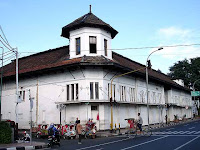 I finally arrived in Bandung after an eight hour train ride from Yogyakarta. If Yogya is the cradle of Javanese culture, Bandung is said to be the cradle of Sundanese culture. The weather was a bit cooler since Indonesia's fourth largest city is 2,520 feet above sea level. And because it's closer to the equator, average temperatures don't vary much from a low of 22.9 C in July to a high of 24.2 C in May. The city is known for its large collection of Dutch colonial and tropical Art Deco structures. And thus, I decided to take a walk around Bandung even just for a few hours to check them out.
I finally arrived in Bandung after an eight hour train ride from Yogyakarta. If Yogya is the cradle of Javanese culture, Bandung is said to be the cradle of Sundanese culture. The weather was a bit cooler since Indonesia's fourth largest city is 2,520 feet above sea level. And because it's closer to the equator, average temperatures don't vary much from a low of 22.9 C in July to a high of 24.2 C in May. The city is known for its large collection of Dutch colonial and tropical Art Deco structures. And thus, I decided to take a walk around Bandung even just for a few hours to check them out.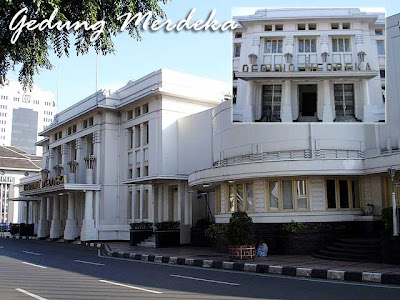 So from the Bandung Train Station, itself an Art Deco structure, I walked towards Jalan Asia Afrika where many of the buildings could be found. Since it was still early, I waited at the steps of the Gedung Merdeka for the Museum of the Asian-African Conference to open.
So from the Bandung Train Station, itself an Art Deco structure, I walked towards Jalan Asia Afrika where many of the buildings could be found. Since it was still early, I waited at the steps of the Gedung Merdeka for the Museum of the Asian-African Conference to open. The museum chronicles the events of the 1955 conference which has been Bandung's claim to fame. Twenty-nine young (and old) nations from Asia and Africa met in order to build solidarity with the continuous fall of colonialism. I was able to see the hall where the conference was held. There are two rows of flags, the first with those of the 29 countries which participated in the 1955 conference; and the second, the countries of Asia and Africa during the 50th anniversary in 2005, obviously a much larger group since most countries in the region gained their independence after 1955. One thing it chronicled as well was the change in the blue field of the Philippine flag which was much lighter in 1955.
The museum chronicles the events of the 1955 conference which has been Bandung's claim to fame. Twenty-nine young (and old) nations from Asia and Africa met in order to build solidarity with the continuous fall of colonialism. I was able to see the hall where the conference was held. There are two rows of flags, the first with those of the 29 countries which participated in the 1955 conference; and the second, the countries of Asia and Africa during the 50th anniversary in 2005, obviously a much larger group since most countries in the region gained their independence after 1955. One thing it chronicled as well was the change in the blue field of the Philippine flag which was much lighter in 1955. Close to the Gedung Merdeka is another Art Deco gem of Bandung, the Savoy Homann Hotel, its new design completed in 1938.
Close to the Gedung Merdeka is another Art Deco gem of Bandung, the Savoy Homann Hotel, its new design completed in 1938. After about four hours in Bandung, I decided to make my way back to the train station for my trip back to Jakarta. I had been told that the views along the way would be refreshing. And I was not disappointed. They also had rice terraces. And the thing I liked about the rice terraces there was the houses blended well with their surroundings since they all had clay tile roofs. I hope they cover the galvanized iron roofs in Banaue and other Cordillera towns with cogon grass or nipa so that they don't look like eyesores amidst our grander and more majestic rice terraces.
After about four hours in Bandung, I decided to make my way back to the train station for my trip back to Jakarta. I had been told that the views along the way would be refreshing. And I was not disappointed. They also had rice terraces. And the thing I liked about the rice terraces there was the houses blended well with their surroundings since they all had clay tile roofs. I hope they cover the galvanized iron roofs in Banaue and other Cordillera towns with cogon grass or nipa so that they don't look like eyesores amidst our grander and more majestic rice terraces. Bandung is also known for its shopping. But I didn't get a chance to shop. Maybe next time. It's best if you shop with friends and many locals say Bandung is a group destination. And if you're wondering about the title, "Halo-halo Bandung" is a popular revolutionary song which was inspired by the 1946 Bandung Lautan Api (Bandung Sea of Fire) where the residents and combatants, as a sign of defiance to the Dutch who demanded the surrender of the Indonesians, deliberately burned the southern part of the city. More photos in Multiply.
Bandung is also known for its shopping. But I didn't get a chance to shop. Maybe next time. It's best if you shop with friends and many locals say Bandung is a group destination. And if you're wondering about the title, "Halo-halo Bandung" is a popular revolutionary song which was inspired by the 1946 Bandung Lautan Api (Bandung Sea of Fire) where the residents and combatants, as a sign of defiance to the Dutch who demanded the surrender of the Indonesians, deliberately burned the southern part of the city. More photos in Multiply.Technorati Tags:
bandung,
west java,
indonesia,
travel,
travel blog,
art deco,
heritage
I arrived in Yogyakarta early in the morning of June 5. The train station was a heritage building, as it is with most of the major train stations in Java. My batchmates in Jakarta had made arrangements for Dimas, a PY in 2004, to meet me at the station. Since I was starving after that long trip, he took me to this Nasi Gudeg place for breakfast. As with most Central Javanese dishes, Nasi Gudeg was a bit sweet. It’s actually a complex dish composed of several component dishes. I appreciated it more after I visited their kitchen, learning about the overnight cooking process. The first component dish, duck eggs are first hard-boiled, then shelled, then re-boiled again with different ingredients and spices until it reaches a dark brown color. Another component is the chicken dish. They were also grating coconuts and chopping some young jackfruit at the back for another dish. There was also a tofu and cow skin dish. The last component was white rice. They prepared large servings beginning the night before for sales the next day.
As with most Central Javanese dishes, Nasi Gudeg was a bit sweet. It’s actually a complex dish composed of several component dishes. I appreciated it more after I visited their kitchen, learning about the overnight cooking process. The first component dish, duck eggs are first hard-boiled, then shelled, then re-boiled again with different ingredients and spices until it reaches a dark brown color. Another component is the chicken dish. They were also grating coconuts and chopping some young jackfruit at the back for another dish. There was also a tofu and cow skin dish. The last component was white rice. They prepared large servings beginning the night before for sales the next day. We met up with Happy, a PY in 2005, and proceeded to the Kraton, the historic palace complex of the Sultan. Yogyakarta is actually a special region in Indonesia since its top officials are not elected. Rather, the reigning Sultan of Yogyakarta and Prince of Pakualaman are governor and vice-governor respectively. This resulted from a statement by the rulers of both principalities during the declaration of Indonesian independence that the Sultanate of Yogyakarta and Regency of Pakualaman would be part of Indonesia. There have been issues though, with the Indonesian central government failing to honor the agreement in 1988. But to make the long story short, the current sultan is also governor of Yogya.
We met up with Happy, a PY in 2005, and proceeded to the Kraton, the historic palace complex of the Sultan. Yogyakarta is actually a special region in Indonesia since its top officials are not elected. Rather, the reigning Sultan of Yogyakarta and Prince of Pakualaman are governor and vice-governor respectively. This resulted from a statement by the rulers of both principalities during the declaration of Indonesian independence that the Sultanate of Yogyakarta and Regency of Pakualaman would be part of Indonesia. There have been issues though, with the Indonesian central government failing to honor the agreement in 1988. But to make the long story short, the current sultan is also governor of Yogya. Among the places we visited were the coronation hall and a part of the main palace. You could see the servants of the sultan in traditional Javanese attire walking around the palace barefoot since they are not allowed to put on footwear. And male servants have a kris knife tucked behind them.
Among the places we visited were the coronation hall and a part of the main palace. You could see the servants of the sultan in traditional Javanese attire walking around the palace barefoot since they are not allowed to put on footwear. And male servants have a kris knife tucked behind them. In one of the halls, there was a gamelan performance. It was lucky there was one that day since they don’t perform every day. In another hall was a museum dedicated to the life of the previous sultan, Sri Sultan Hamengkubuwono IX, who even became vice-president of Indonesia from 1973 to 1978. After the touring the palace, I took a bus to Borobudur.
In one of the halls, there was a gamelan performance. It was lucky there was one that day since they don’t perform every day. In another hall was a museum dedicated to the life of the previous sultan, Sri Sultan Hamengkubuwono IX, who even became vice-president of Indonesia from 1973 to 1978. After the touring the palace, I took a bus to Borobudur. I arrived back in Yogya late afternoon June 6, after visiting Borobudur and Prambanan. I first looked for a place to stay for the night in the Jalan Sosrowijayan area where most of the budget hotels can be located; then took a stroll around the Jalan Marlioboro area to do some souvenir shopping. I got myself a pair of wayang golek (puppets) and masks among others.Then for dinner, I went to one of the warungs which appear along Marlioboro every evening. You sit on woven mats while eating dinner. One of the favorites is the ayam goreng (fried chicken) which they say is marinated in coconut milk. I also had lalap (fresh vegetables) and sambal (chili) to accompany the dish.
I arrived back in Yogya late afternoon June 6, after visiting Borobudur and Prambanan. I first looked for a place to stay for the night in the Jalan Sosrowijayan area where most of the budget hotels can be located; then took a stroll around the Jalan Marlioboro area to do some souvenir shopping. I got myself a pair of wayang golek (puppets) and masks among others.Then for dinner, I went to one of the warungs which appear along Marlioboro every evening. You sit on woven mats while eating dinner. One of the favorites is the ayam goreng (fried chicken) which they say is marinated in coconut milk. I also had lalap (fresh vegetables) and sambal (chili) to accompany the dish. The next morning, after purchasing my ticket to Bandung at the train station, I took a walk around Yogya. First stop was Vredeburg Fort which is located in an area of fine colonial buildings. The fort was built by the Dutch in 1765 to protect the governor. From Vredeburg, I walked to the Kraton then to Taman Sari or the Water Castle, a pleasure place for the royal family, with bathing pools where the sultan relaxed with a bevy of beautiful women. It was quite a walk and the hotel was a bit far. So I decided to take a becak (rickshaw) back to the hotel.
The next morning, after purchasing my ticket to Bandung at the train station, I took a walk around Yogya. First stop was Vredeburg Fort which is located in an area of fine colonial buildings. The fort was built by the Dutch in 1765 to protect the governor. From Vredeburg, I walked to the Kraton then to Taman Sari or the Water Castle, a pleasure place for the royal family, with bathing pools where the sultan relaxed with a bevy of beautiful women. It was quite a walk and the hotel was a bit far. So I decided to take a becak (rickshaw) back to the hotel. In the afternoon, I took a one-hour train to Solo which cost me Rp7,000. It was a big risk since I might miss my train to Bandung, but I had wanted to visit the Sangiran Early Man Site, which is the third UNESCO site in Central Java. From the Solobalapan Station, I took a becak to the Solo Bus Station. My plan was to take a Purowadadi-bound bus and get off at the junction to Sangiran. But good thing I asked for some advice at the tourist information counter.
In the afternoon, I took a one-hour train to Solo which cost me Rp7,000. It was a big risk since I might miss my train to Bandung, but I had wanted to visit the Sangiran Early Man Site, which is the third UNESCO site in Central Java. From the Solobalapan Station, I took a becak to the Solo Bus Station. My plan was to take a Purowadadi-bound bus and get off at the junction to Sangiran. But good thing I asked for some advice at the tourist information counter.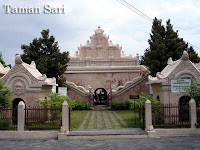 They offered that I take an ojek (motorcycle) straight to Sangiran for Rp35,000 (US$4) which sounded expensive at first. But they explained that the bus would cost Rp5,000 one-way and when I got down at the junction, I’d have to haggle with an ojek for the four-kilometer trip to the museum which could amount to Rp15,000 or even more since I was a foreigner. Add the time factor and uncertainty since the bus was slower and finding an ojek to take me to the museum might have been a hassle. So this turned out to be a good deal.
They offered that I take an ojek (motorcycle) straight to Sangiran for Rp35,000 (US$4) which sounded expensive at first. But they explained that the bus would cost Rp5,000 one-way and when I got down at the junction, I’d have to haggle with an ojek for the four-kilometer trip to the museum which could amount to Rp15,000 or even more since I was a foreigner. Add the time factor and uncertainty since the bus was slower and finding an ojek to take me to the museum might have been a hassle. So this turned out to be a good deal.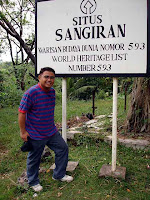 Few people actually visit the place because there’s nothing much to see except a few fossils and replicas of Java Man skulls. In fact, I was the only visitor at the museum that day. But for a UNESCO World Heritage addict like me, it was a must visit. I was back in Solo earlier than expected which meant I would be early in Yogya and had a lot of time to spare before boarding the train to Bandung.More photos in 2007-06-06 Yogyakarta, Indonesia and 2007-06-07 Yogyakarta, Indonesia.
Few people actually visit the place because there’s nothing much to see except a few fossils and replicas of Java Man skulls. In fact, I was the only visitor at the museum that day. But for a UNESCO World Heritage addict like me, it was a must visit. I was back in Solo earlier than expected which meant I would be early in Yogya and had a lot of time to spare before boarding the train to Bandung.More photos in 2007-06-06 Yogyakarta, Indonesia and 2007-06-07 Yogyakarta, Indonesia.Technorati Tags:
yogyakarta,
solo,
sangiran,
central java,
indonesia,
travel,
travel blog,
heritage,
unesco,
java man
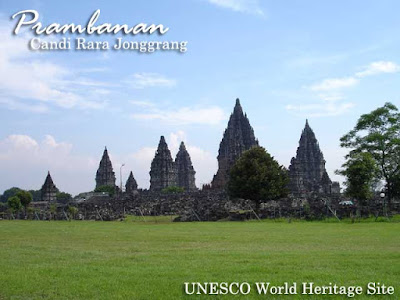 Prambanan, another UNESCO World Heritage site in Central Java, is the largest Hindu temple compound in Indonesia. To get to Prambanan from Borobudur, I had to take a bus to the main bus terminal of Yogya, the Umbulharjo Bus Terminal, and transfer to a Solo-bound bus, getting off at the gates of the temple. I spent Rp3,000 for the trip to Prambanan from Yogya. You could easily finish the park in half a day which is composed of the main temple, Candi Rara Jonggrang (which is what most refer to when they say Prambanan), and three others namely Candi Lumbung, Candi Bubrah and Candi Sewu.
Prambanan, another UNESCO World Heritage site in Central Java, is the largest Hindu temple compound in Indonesia. To get to Prambanan from Borobudur, I had to take a bus to the main bus terminal of Yogya, the Umbulharjo Bus Terminal, and transfer to a Solo-bound bus, getting off at the gates of the temple. I spent Rp3,000 for the trip to Prambanan from Yogya. You could easily finish the park in half a day which is composed of the main temple, Candi Rara Jonggrang (which is what most refer to when they say Prambanan), and three others namely Candi Lumbung, Candi Bubrah and Candi Sewu. There are 224 temples in the Prambanan complex, which is named after the village where it is located. Three are main temples namely Brahma Temple in the north, Vishnu Temple in the south, and the biggest among the three which lies between Brahma and Vishnu temples, is the 47-meter high Shiva Temple.Characterized by tall and pointed architecture typical of Hindu temples, the main temple incurred significant damage during the 2006 earthquake which hit Yoyga which is why it was fenced out and you could only view it from a safe distance.
There are 224 temples in the Prambanan complex, which is named after the village where it is located. Three are main temples namely Brahma Temple in the north, Vishnu Temple in the south, and the biggest among the three which lies between Brahma and Vishnu temples, is the 47-meter high Shiva Temple.Characterized by tall and pointed architecture typical of Hindu temples, the main temple incurred significant damage during the 2006 earthquake which hit Yoyga which is why it was fenced out and you could only view it from a safe distance. Candi Sewu on the other hand, is actually a Buddhist temple and the second largest in Central Java after Borobudur. The fact that the Hindu Rara Jonggrang Temple and Buddhist Sewu Temple were built 800 meters apart indicated that Hindus and Buddhists lived in harmony with each other. The Sewu Temple complex has 249 temples, consisting of one main temple, eight apit temples and 240 perwara temples. The main temple forms a polygon of 20 corners with a diameter of 29 meters and a height of 30 meters.After a late lunch at a warung along the road, I waited for a bus back to the Umbulharjo Terminal in Yogya and took bus no. 4 to the Jalan Marlioboro area.
Candi Sewu on the other hand, is actually a Buddhist temple and the second largest in Central Java after Borobudur. The fact that the Hindu Rara Jonggrang Temple and Buddhist Sewu Temple were built 800 meters apart indicated that Hindus and Buddhists lived in harmony with each other. The Sewu Temple complex has 249 temples, consisting of one main temple, eight apit temples and 240 perwara temples. The main temple forms a polygon of 20 corners with a diameter of 29 meters and a height of 30 meters.After a late lunch at a warung along the road, I waited for a bus back to the Umbulharjo Terminal in Yogya and took bus no. 4 to the Jalan Marlioboro area.Technorati Tags:
yogyakarta,
central java,
indonesia,
travel,
travel blog,
heritage,
unesco,
prambanan
 I finally arrived in Bandung after an eight hour train ride from Yogyakarta. If Yogya is the cradle of Javanese culture, Bandung is said to be the cradle of Sundanese culture. The weather was a bit cooler since Indonesia's fourth largest city is 2,520 feet above sea level. And because it's closer to the equator, average temperatures don't vary much from a low of 22.9 C in July to a high of 24.2 C in May. The city is known for its large collection of Dutch colonial and tropical Art Deco structures. And thus, I decided to take a walk around Bandung even just for a few hours to check them out.
I finally arrived in Bandung after an eight hour train ride from Yogyakarta. If Yogya is the cradle of Javanese culture, Bandung is said to be the cradle of Sundanese culture. The weather was a bit cooler since Indonesia's fourth largest city is 2,520 feet above sea level. And because it's closer to the equator, average temperatures don't vary much from a low of 22.9 C in July to a high of 24.2 C in May. The city is known for its large collection of Dutch colonial and tropical Art Deco structures. And thus, I decided to take a walk around Bandung even just for a few hours to check them out. So from the Bandung Train Station, itself an Art Deco structure, I walked towards Jalan Asia Afrika where many of the buildings could be found. Since it was still early, I waited at the steps of the Gedung Merdeka for the Museum of the Asian-African Conference to open.
So from the Bandung Train Station, itself an Art Deco structure, I walked towards Jalan Asia Afrika where many of the buildings could be found. Since it was still early, I waited at the steps of the Gedung Merdeka for the Museum of the Asian-African Conference to open. The museum chronicles the events of the 1955 conference which has been Bandung's claim to fame. Twenty-nine young (and old) nations from Asia and Africa met in order to build solidarity with the continuous fall of colonialism. I was able to see the hall where the conference was held. There are two rows of flags, the first with those of the 29 countries which participated in the 1955 conference; and the second, the countries of Asia and Africa during the 50th anniversary in 2005, obviously a much larger group since most countries in the region gained their independence after 1955. One thing it chronicled as well was the change in the blue field of the Philippine flag which was much lighter in 1955.
The museum chronicles the events of the 1955 conference which has been Bandung's claim to fame. Twenty-nine young (and old) nations from Asia and Africa met in order to build solidarity with the continuous fall of colonialism. I was able to see the hall where the conference was held. There are two rows of flags, the first with those of the 29 countries which participated in the 1955 conference; and the second, the countries of Asia and Africa during the 50th anniversary in 2005, obviously a much larger group since most countries in the region gained their independence after 1955. One thing it chronicled as well was the change in the blue field of the Philippine flag which was much lighter in 1955. Close to the Gedung Merdeka is another Art Deco gem of Bandung, the Savoy Homann Hotel, its new design completed in 1938.
Close to the Gedung Merdeka is another Art Deco gem of Bandung, the Savoy Homann Hotel, its new design completed in 1938. After about four hours in Bandung, I decided to make my way back to the train station for my trip back to Jakarta. I had been told that the views along the way would be refreshing. And I was not disappointed. They also had rice terraces. And the thing I liked about the rice terraces there was the houses blended well with their surroundings since they all had clay tile roofs. I hope they cover the galvanized iron roofs in Banaue and other Cordillera towns with cogon grass or nipa so that they don't look like eyesores amidst our grander and more majestic rice terraces.
After about four hours in Bandung, I decided to make my way back to the train station for my trip back to Jakarta. I had been told that the views along the way would be refreshing. And I was not disappointed. They also had rice terraces. And the thing I liked about the rice terraces there was the houses blended well with their surroundings since they all had clay tile roofs. I hope they cover the galvanized iron roofs in Banaue and other Cordillera towns with cogon grass or nipa so that they don't look like eyesores amidst our grander and more majestic rice terraces. Bandung is also known for its shopping. But I didn't get a chance to shop. Maybe next time. It's best if you shop with friends and many locals say Bandung is a group destination. And if you're wondering about the title, "Halo-halo Bandung" is a popular revolutionary song which was inspired by the 1946 Bandung Lautan Api (Bandung Sea of Fire) where the residents and combatants, as a sign of defiance to the Dutch who demanded the surrender of the Indonesians, deliberately burned the southern part of the city. More photos in Multiply.
Bandung is also known for its shopping. But I didn't get a chance to shop. Maybe next time. It's best if you shop with friends and many locals say Bandung is a group destination. And if you're wondering about the title, "Halo-halo Bandung" is a popular revolutionary song which was inspired by the 1946 Bandung Lautan Api (Bandung Sea of Fire) where the residents and combatants, as a sign of defiance to the Dutch who demanded the surrender of the Indonesians, deliberately burned the southern part of the city. More photos in Multiply.











